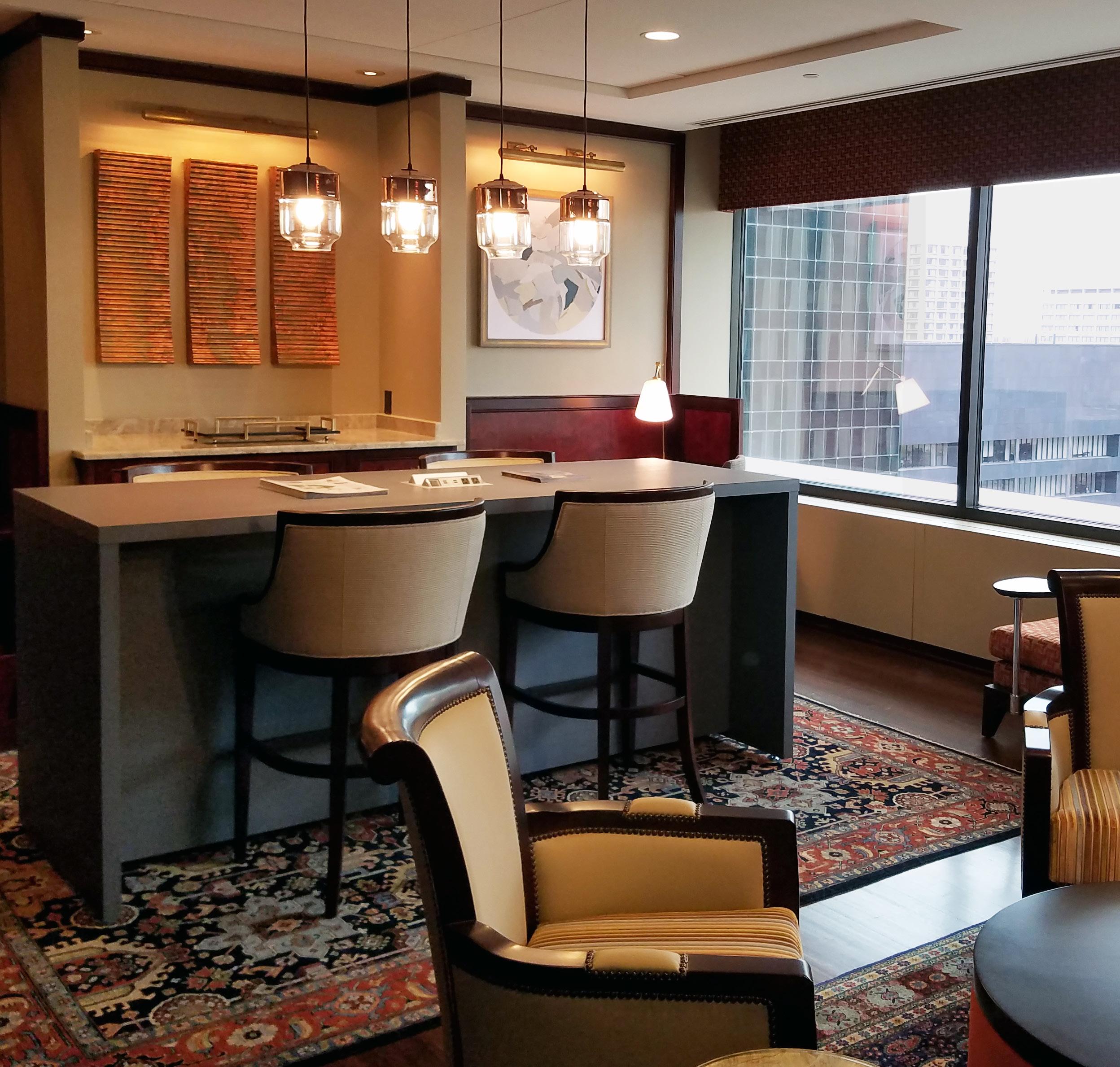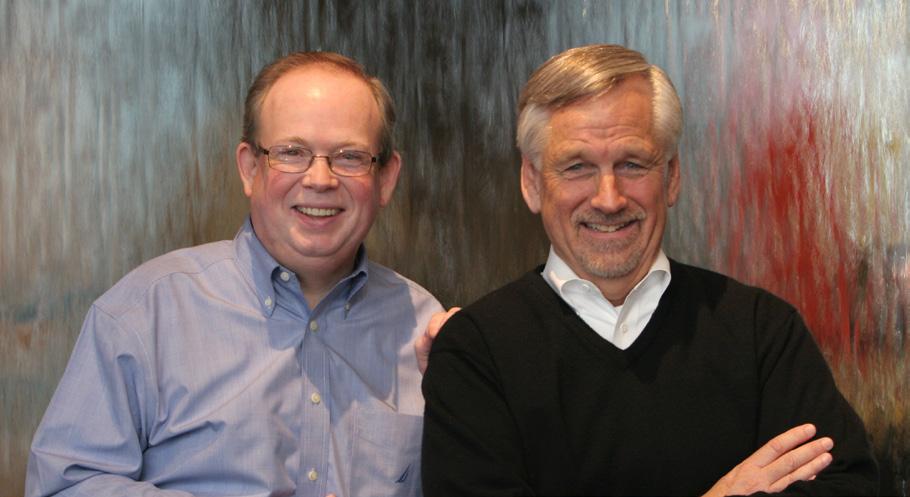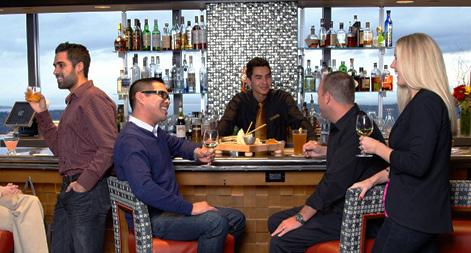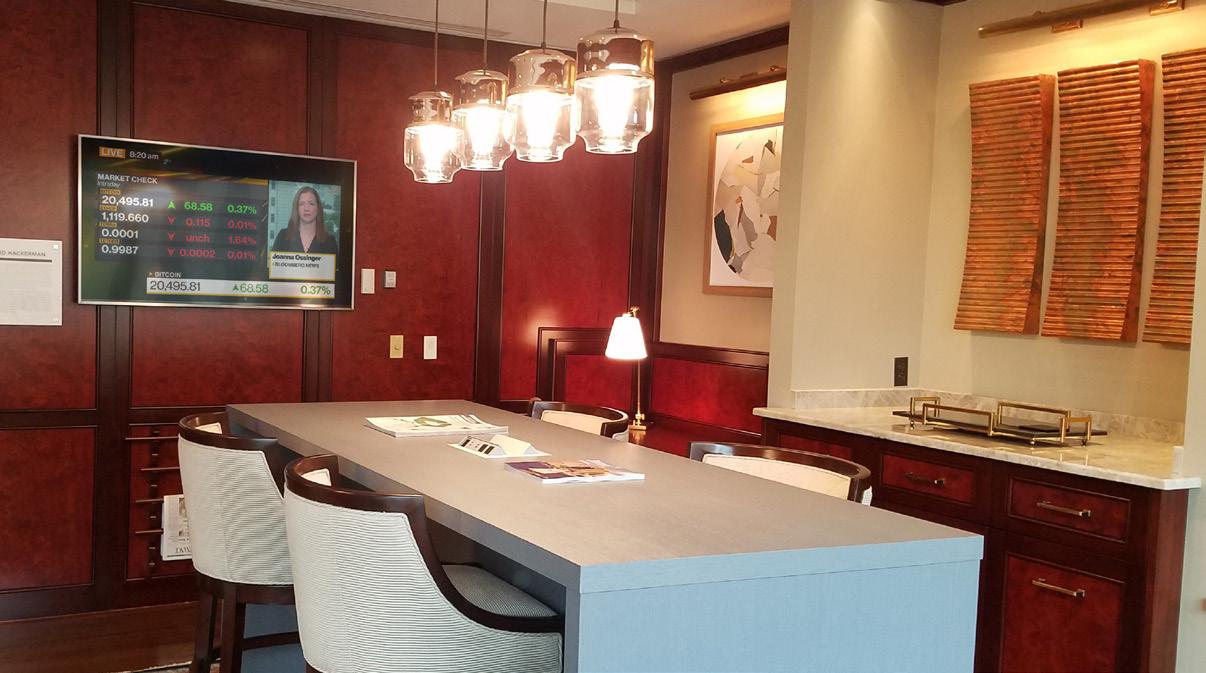
CHAMBERS ISSUE N O 16 • FALL 2017 CLUB ROAD A Chambers Publication Plus p.12 Meet the Manager with Paul Spencer, GM Birmingham Athletic Club What’sInside? The Center Club Baltimore, MD Adapting to MODERN TIMES How Private City Clubs are Evolving to Meet the Needs of Today’s Members p.4 Hot Product Trends p.2 Multi-Generational Workforces p.8 Making the Most of Your F&B Department p.10 Year-Round Amenities p.11
Friends —
It’s been a busy few months! We hope everyone is enjoying the autumn season and the holidays. As many clubs gear up for colder months ahead, and others prepare for the snow birds to arrive, we focus on maintaining a dynamic club experience no matter what time of year.
For many clubs, this means modernizing facilities and programs. In this issue, we discuss the evolution of city clubs and what other private clubs can learn from them. Read about hot product trends that incorporate the latest technologies, how to provide supplemental programs that cater to your members’ unique interests, and how to make sure you are maximizing your F&B facilities and operations.
We also discuss the challenges— and benefits—of managing a multigenerational workforce, and introduce our Meet the Manager series, which will highlight creative programs and policies being implemented by young managers.

Enjoy the issue and have a wonderful holiday season!
HOT PRODUCTS IN PRIVATE CLUB DESIGN

Technology advances have given rise to some new and inventive twists on “old” products we know and love. Here are some hot products trending in private club design today. Click on each to learn more!
Device Chargers
Installing wireless charging table tops, in-locker ports, or under-bar outlets are just some of the many discrete ways you can help your members stay charged. Read more >>

Covert TVs
Is it a mirror or a TV? Or is that artwork on the wall? Could be any of the above! These hidden TVs help transform your space with the simple click of a button. Read more >>
 Rick Snellinger Bob Hickman President & CEO Chairman of the Board
Rick Snellinger Bob Hickman President & CEO Chairman of the Board
 EMAIL RICK EMAIL BOB
EMAIL RICK EMAIL BOB


FEATURED A NOTE FROM CHAMBERS CLUB ROUNDUP
CHAMBERSUSA .COM 2 ] BALTIMORE / DALLAS / MINNEAPOLIS / DC
CONNECT:
Porcelain Tiles

Keep the natural look without breaking the bank! These simulated porcelain tiles look like the real deal, but are more durable and less expensive than natural materials such as stone, wood, and marble. Read more >>

Super Showers
Take your locker room experience to the next level with rainfall showerheads, giving your members a taste of the spa for a lot less time and money! Read more >>

Sparkle Tables
Sparkle tables combine technology with the oldfashion drawing and activity table to create an interactive and creative social experience for young children. Read more >>

Digital Wallcoverings
Murals are one option, but digital wallcoverings might be even better! Save time and reduce cost with these digital wallcoverings—without cheapening the aesthetic of the space. Read more >>

FEATURED CLUB ROAD Issue No 16 / Fall 2017 CLUB ROAD is a Chambers publication. Editor-in-Chief / Creative Director: Lauren Gordon clubroad@chambersusa.com 410.727.4535 2 Hot Products Trending in Private Club Design 4 Changing Tides How Private City Clubs Are Adapting to Modern Times 8 Club Experience Managing a Multi-Generational Workforce 10 Down to Business Making the Most of Your F&B Department 11 Maximizing Club Activities to increase Membership Value 12 Meet the Manager with Paul Spencer PLANNING • ARCHITECTURE INTERIOR DESIGN • PURCHASING CHAMBERSUSA .COM CLUB ROAD GET IN TOUCH! CLUBROAD@CHAMBERSUSA.COM / 410.727.4535

Garden Patio Duquesne Club Pittsburgh, PA CHAMBERSUSA .COM 4 ] / CLUBROAD ISSUE 16 / FALL 2017 FEATURED
Adapting to MODERN TIMES
How Private City Clubs are Evolving to Meet the Needs of Today’s Dynamic Memberships
F or decades, private city clubs have been establishments that are well-regarded and admired by successful individuals all over the world. At the same time, city clubs have sometimes earned the reputation of being secluded or secretive, leaving many to ponder what they’re really all about.
The wise Greek philosopher Heraclitus once said, “Change is the only constant in life.” Just as businesses cannot expect to survive without adapting to changing markets, private clubs cannot expect to thrive without adapting to modern lifestyles and changing demographics. So how can clubs continue to attract members and appeal to multiple generations while still maintaining their reputation and prestige?
From policy updates, to facility trends, to program enhancements—private city clubs are making changes to help them do just that. TURN THE PAGE TO READ MORE!
CLUBROAD@CHAMBERSUSA.COM [ 5 FEATURED
“The club has become a place where members want to live, work and play in the same space...”
—Mitchell Platt, General Manager of Cosmos Club
REFORMING DRESS CODES
The topic of ‘dress code policies’ is often a controversial one in clubs. Many members of older generations are accustomed to ‘coat and tie’ dress policies. These members are often reluctant to relax dress code policies for fear of becoming too casual and damaging the club’s reputation. On the other hand, today’s younger generations are not required to dress formally in their careers and day to day life. This means that stricter dress code policies tend to deter them from utilizing the club in ways they’d like.
“Members—especially younger members— want to be able to use their club spontaneously,” says Rick Snellinger, President and CEO of Chambers. “If they have to think about packing a bag with a change of clothes while they are getting ready for work in the morning, they’ll likely decide that it just isn’t worth the hassle. Instead, they’ll decide to go elsewhere for dinner or drinks after work. This takes the club off of their radar, which is the exact opposite of what we’re trying to...
ADAPTING CELL PHONE POLICIES

Many city clubs—and private clubs in general— have come a long way with regard to cell phone policies. Though some clubs still prohibit the use of devices, many are becoming more lenient with regard to cell phone use—or, at the very least, adapting them to be a little more tech-friendly. “There are only three areas in our Club where members cannot use cell phones,” says Mark Tunney of the Union League Club of Chicago’s facilities.

In fact, the Club has embraced cell phone use by making outlets readily available for the members. “In our recent renovation, we took great care to incorporate outlets throughout the dining room and under the bar for easy access,” says Tunney. Today’s technology has given rise to various options for offering discrete charging solutions that offer convenience without being aesthetically offensive.
The Cosmos Club in Washington, DC has taken a similar approach. Mitchell Platt remarks, “We had to respond to the smartphone generation...
Find out more about updated policies...
Read more about dress code reform...
CHAMBERSUSA .COM 6 ] / CLUBROAD ISSUE 16 / FALL 2017 FEATURED
ENHANCING CONNECTIVITY
If cell phones are being adapted into regular club life, we must then look to other ‘smart’ devices that our members are accustomed to using. Global Workplace Analytics (June 2017) reports that not only does 50% of the U.S. workforce have a career that is compatible with at least partial telecommuting, but regular ‘work-at-home’ practices have grown by 115% since 2005—nearly 10 times faster than the rest of the workforce. Today, working private club members are increasingly mobile and constantly connected—and are beginning to expect the same capabilities from their club.
“More and more, we are incorporating business lounge style spaces into our private club designs,” says Charlie Turner, VP/Director of Interior Design at Chambers. “Members want to be at home or at the club—and if they can ‘work from home’ in the comfort of their club, it’s a win-win.” Chambers’ recent renovations at the Duquesne Club in Pittsburgh include an Executive Lounge complete with WiFi connectivity, individual computer carrels and...

MODERNIZING FACILITIES
Whether your club is in the midst of renovations, has recently completed capital improvements, or is in the early stages of planning, it’s never too late to start thinking toward the future—and incorporating some of the latest facilities trends in city clubs. “The club has become a place where members want to live, work and play in the same space,” Platt wisely states, noting that Cosmos Club is continually analyzing facilities to offer more opportunities for members to do just that.
In recent renovations at Cosmos Club, the Main Dining Room was updated with new finishes and flexible seating...The new 1878 Grille Room features a specialty bar with the Club’s own unique craft cocktails, beer and wine on tap...
More about modernizing facilities...
OPENING DOORS
Private clubs are truly special places with unique and deeply personal spaces—but remember, it is a ‘private’ club, not a ‘secret’ club. And though city clubs once had a reputation for being secretive and secluded, many have realized the benefit of being more visible, especially within their community.
ULCC is one such club that has done just that. “Our building is positioned along two very busy streets in Chicago—Jackson Blvd and Federal Street,” says Tunney. “Many people...
Keep reading about connectivity...
Learn more by visiting our blog...
FEATURED CLUBROAD@CHAMBERSUSA.COM [ 7
The key is to determine how best to build collaboration among them.
Managing a MULTIGENERATIONAL Workforce







CHAMBERSUSA .COM 8 ] / CLUBROAD ISSUE 16 / FALL 2017 CLUB EXPERIENCE
With Insights from Dr. Joseph Michelli, CEO of TheMichelliExperience
Dr.JosephMichelli
—Dr.Joseph Michelli
In the private clubs of today, it is possible to see as many as five generations of individuals in one membership. For managers and club leaders, this makes delivering a cross-generational member experience not only important, but necessary. On the flip side, many club managers may also be overseeing employees aging anywhere from 17 to 70. That’s a lot of generations in the mix—and a lot for managers to juggle!

So how can club leaders offer a consistent and exceptional experience with so many different variables involved?
We spoke with Dr. Joseph Michelli, Chief Experience Officer at The Michelli Experience, who speaks frequently on the topic and advises that while the “multigenerational workforce” presents its own unique set of challenges, it also provides great opportunity for things like reciprocal mentoring, collaboration and team building An international speaker and New York Times #1 bestselling author, Dr. Michelli and his team consult with companies all over the world—including private clubs—to help them deliver engaging service experiences.
“There have always been multi-generational workforces,” Dr. Michelli remarks, “but it has become more complex now that individuals are staying in the workforce longer.” He notes that the ebb and flow that we see in the
market also extends to the workforce, but employers should not see this as a daunting feat that needs to be overcome. “It really gets down to practical managing,” he says. “The key is to determine how best to build collaboration among them.”
Working Together
One key concept Michelli discusses with his teams is reverse mentoring or reciprocal mentoring. Traditionally, many hear the term ‘mentor’ and think of the older generation showing the younger generations the ropes. In reality, mentoring goes both ways. “This really is a fascinating time for our history,” he remarks. “We have to consider what everyone brings to the table and how we can teach each other.”
Michelli suggests identifying skillsets of various employees and seeing how best to leverage them. For example, younger generations are digital natives that can teach older generations a lot about tech. Consider hosting a series of “brown bag lunches” where different staff members can help teach their colleagues something new. This will help develop your team’s technical skills while building relationships and leadership skills simultaneously.
Understanding Core Values
Simply stated: different generations have different values. What is important to someone born in the ‘50s is not necessarily going to be the same as someone who was...

CLUBROAD@CHAMBERSUSA.COM [ 9 CLUB EXPERIENCE
Click to keep reading and learn more!
It is often said that the kitchen is the heart of any private club. A club’s food and beverage department is one of the most important aspects of the private club experience—the one amenity that every member in the club utilizes. And while increasing F&B revenue isn’t a magical solution to improve a club’s financial position, it can certainly help.
When it comes to the bottom line, there are two clear ingredients: revenue and cost. The obvious goal is to increase revenue while reducing costs wherever possible. But this doesn’t necessarily mean increasing prices and cutting back on labor costs or hours of operation. Instead, clubs must implement dining practices that cater to member needs and encourage increased utilization (thereby increasing revenue), and carefully study F&B operational costs to determine opportunities for greater efficiency. Oftentimes, this inefficiency can be found in energy costs associated with the equipment itself.
Increasing Utilization
Offering culinary alternatives that mirror members’ spontaneous, cultured lifestyles >>

Local Restaurants
Complementing—not competing with—local restaurants to keep your club on the radar >>
Sustainable Equipment
Making sure your equipment is efficient—working for you rather than against you >>
Energy Savings
Finding savings with new energy efficient policies may be easier than you think >>
CHAMBERSUSA .COM 10 ] / CLUBROAD ISSUE 16 / FALL 2017 DOWN TO BUSINESS
In the end, augmenting increased utilization with energy savings can make the difference, helping clubs maximize the potential of the F&B department as a whole.
Visit our blog to read the full article... Click each topic below to learn more. Making the Most of Your Club’s F&B Department
Maximizing

YOUR CLUB ACTIVITIES
Supplemental programS that IncreaSe memberShIp Value
The private club industry has experienced significant changes in the last several years in response to evolving lifestyles and demographic shifts. A private club membership is a significant investment, so members want to know that they can maximize the value of their dues and investment by spending their time either at home or at the club—making it a true home away from home.
It is important, then, to offer members with as many opportunities to use their club as possible, during as many months of the year as possible—a true perennial club experience. So when the months are cold or the weather is less than ideal or someone is looking for a
fun activity on any ol’ Wednesday evening, how can we continue to encourage members to visit the club? Here, we’ve compiled a list of some specific programs that can help do just that! Click below to learn more about:
Speaker SerIeS
artISt In reSIdence
cookIng claSSeS
member mIxerS
IntraclubS
JunIor commItteeS
read the Full artIcle
CLUBROAD@CHAMBERSUSA.COM [ 11
SOCIAL REGISTER
MEET THE MANAG ER
Private clubs are becoming increasingly more dynamic as the industry continues to adapt to a changing and complex world. In many ways, clubs that have been successful in this regard are managed by creative and innovative individuals bringing a fresh yet respectful perspective to the private club experience.

IN THIS MEET THE MANAGER SERIES, we’ll highlight young, up-and-coming managers who are truly forging ahead in these times of change.
In this issue, we met with Paul Spencer, General Manager of Birmingham Athletic Club (BAC) in Michigan. A certified sommelier with a background in the culinary arts, Spencer has a history of enhancing the food and service experiences, supporting membership growth and retention, and developing strategic capital campaigns. We sat down with him to discuss his club journey thus far, as well as some of the exciting changes he has made since his arrival at BAC eighteen months ago.

Getting to Know PAUL SPENCER
GM, Birmingham Athletic Club
CR: How long have you been involved with private clubs?
PS: I have been working in the industry for about 12 years now. I actually studied culinary arts in Scottsdale and was planning to be a Chef, but I was offered the Dining Room Manager position at Meadowbrook Country Club in Michigan... READ MORE >>


CR: What is the biggest change you have noticed at BAC?
PS: At BAC, we have three core values—quality, efficiency and consistency—which impact every aspect of the Club. When I started, I began focusing on service, first and foremost. We’ve also started to offer new programs and dining options that are simple, fast, and casual to cater to young members and their families... READ MORE >>
CR: What are some ways of the ways BAC caters to young families?
PS: We have a variety of indoor and outdoor programs catered toward children of all ages. During the summer, we have Camp BAC, which has a variety of supervised outdoor activities... We actually have a dedicated Kid’s Committee made up of 15 children... READ MORE >>
CR: How have you enhanced communications with your members?


PS: Communication is critical and this has been an area of focus of mine since my arrival at BAC. First, personal connections are key, so I make it a point to get to know each and every member... We have also added a Club App which has been well worth the investment. We use the app for quick, one-click booking for... READ MORE >>
CLICK HERE TO READ THE FULL INTERVIEW!
/ CLUBROAD ISSUE 16 / FALL 2017
CHAMBERSUSA .COM 12 ] CONNECT: BALTIMORE / DALLAS / MINNEAPOLIS / DC
MEET THE MANAGER





 Rick Snellinger Bob Hickman President & CEO Chairman of the Board
Rick Snellinger Bob Hickman President & CEO Chairman of the Board
 EMAIL RICK EMAIL BOB
EMAIL RICK EMAIL BOB



























